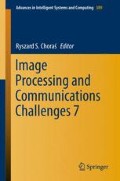Abstract
Two preprocessing approaches, dedicated to the tracking of low SNR objects, are compared—the variance and studentized range. Both approaches are applied using sliding window for noised signal for improving the detection of weak object. Influences of window size are compared and studentized range shows improvement over variance. Both approaches are compared using the Monte Carlo test with numerous tracking scenarios using ST–TBD (Spatio–Temporal Track–Before–Detect) algorithm. The results shows better performance of the studentized range for the detection and tracking weak point objects .
Access this chapter
Tax calculation will be finalised at checkout
Purchases are for personal use only
References
Blackman, S., Popoli, R.: Design and Analysis of Modern Tracking Systems. Artech House (1999)
Keuls, M.: The use of the “studentized range” in connection with an analysis of variance. Euphytica 1(1), 112–122 (1952)
Mazurek, P.: Optimization of bayesian track-before-detect algorithms for GPGPUs implementations. Electr. Rev. R. 86(7), 187–189 (2010)
Mazurek, P.: Hierarchical track-before-detect algorithm for tracking of amplitude modulated signals. Adv. Intel. Soft Comput. 102, 511–518 (2011)
Mazurek, P.: Chi-square statistic for noise object tracking in track-before-detect systems. Poznań Univ. Technol. Acad. J. Electri. Eng. 71, 177–184 (2012)
Mazurek, P.: Code reordering using local random extraction and insertion (LREI) operator for GPGPU-based track-before-detect systems. Soft Comput. 18(6), 1095–1106 (2013)
Mazurek, P.: Track-before-detect filter banks for noise object tracking. Int. J. Electr. Telecommun. 59(4), 325–330 (2013)
Mazurek, P.: Preprocessing using maximal autocovariance for spatio-temporal track-before-detect algorithm. Adv. Intel. Syst. Comput. 233, 45–54 (2014)
Raftery, J.: M.L., A., J.P., B.: Multiple comparison methods for means. SIAM Rev. 44(2), 259–278 (2002)
Stone, L., Barlow, C., Corwin, T.: Bayesian Multiple Target Tracking. Artech House (1999)
Author information
Authors and Affiliations
Corresponding author
Editor information
Editors and Affiliations
Rights and permissions
Copyright information
© 2016 Springer International Publishing Switzerland
About this paper
Cite this paper
Mazurek, P. (2016). Studentized Range for Spatio–Temporal Track–Before–Detect Algorithm. In: Choraś, R. (eds) Image Processing and Communications Challenges 7. Advances in Intelligent Systems and Computing, vol 389. Springer, Cham. https://doi.org/10.1007/978-3-319-23814-2_20
Download citation
DOI: https://doi.org/10.1007/978-3-319-23814-2_20
Published:
Publisher Name: Springer, Cham
Print ISBN: 978-3-319-23813-5
Online ISBN: 978-3-319-23814-2
eBook Packages: EngineeringEngineering (R0)

